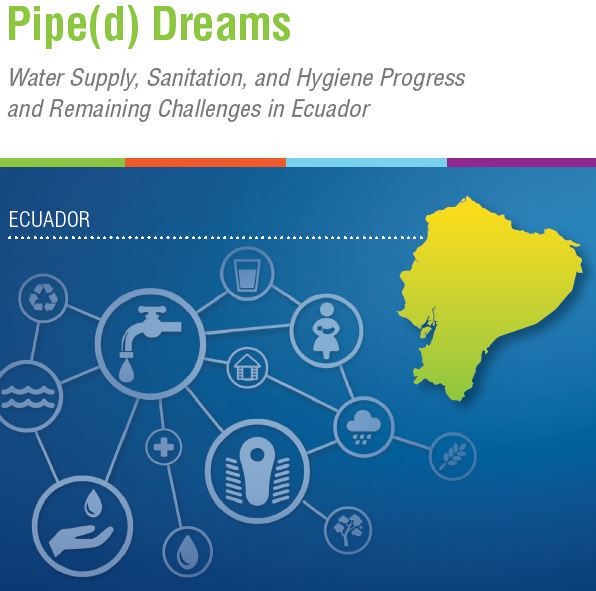Pipe(d) Dreams Water Supply, Sanitation, and Hygiene Progress and Remaining Challenges in Ecuador
Long-term trends in the coverage of water supply and sanitation (WSS) show consistent improvement in water and sanitation coverage in Ecuador since the 1990s. Ecuador has been steadily improving both water supply and sanitation coverage since 1990.1 Indeed, between 1990 and 2015, access to improved water supply (i.e., piped water or other improved sources) increased by 13 percentage points, reaching 87 percent of the population, and improved sanitation increased by 28 percentage points, reaching 85 percent. Coverage improved most dramatically in rural areas, as in urban areas it was already high in the early 1990s. As a result, coverage rates in rural areas have started converging with the high improved coverage rates in urban areas, but gaps still remain. Despite a significant increase in investment in the last decade, however, these trends have not accelerated in rural or urban areas. Despite increased policy attention and investments in the sector by the current government, the long-term positive trend of coverage actually slowed slightly in the last decade.2 This slowdown reflects the increasing marginal cost of closing the gaps in the rising coverage levels, as those who are not covered are typically households in remote areas. But it also reflects a fundamental aspect of the way WSS investments are made in the country, where municipal governments are the main authorities responsible for undertaking investment in WSS. As a result, large municipalities have been able to invest much larger amounts, even if these investments are not aimed at closing coverage gaps with remote and underserved areas. At the same time, access to safely managed water and sanitation is significantly lower than previously reported under the Millennium Development Goals (MDGs). As part of the Water Supply, Sanitation, and Hygiene (WASH) Poverty Diagnostic (WPD), new data were collected to measure access to safely managed services following the Sustainable Development Goals (SDG) definition. The results were striking: just 72.5 percent and 25.1 percent of Ecuadorans have access to safely managed water and to safely managed sanitation services, respectively.3 Furthermore, evidence on quality of water shows that 33 percent of the water consumed in rural areas and 15 percent in urban areas is contaminated with the E. coli bacteria. Regional disparities in access to improved WSS are still significant. Analysis of the coverage of improved water and sanitation by household-level characteristics in 2006 and 2014 shows that a large portion of the improvements at the national level are driven by urban areas, in particular the largest cities (Quito and Guayaquil), while unimproved sanitation remains high in secondary cities, and more so in rural areas. Between 2006 and 2014, improved sanitation increased by more than 20 percentage points in Guayaquil and in rural areas. Urban areas have prioritized public sewerage investments, whereas improvements in rural areas were largely attributable to septic tank solutions, which are mostly private investments. Location and poverty are strong predictors of lacking access to improved WSS. The gap between the top 60 percent and the bottom 40 percent has narrowed more for improved access to water than for improved access to sanitation. Between 2006 and 2014, access to improved WSS increased relatively more among the bottom 40 percent of households; septic tank solutions explained the majority of improved sanitation increases. However, for the vulnerable segments, improvements have been slower, as their coverage with improved water and sanitation in 2014 was below the coverage of higher-income segments in 2006. Finally, although indigenous and Afro-Ecuadorans still have lower improved water coverage than mestizos, there has been significant progress, especially for indigenous households. As for improved sanitation services, although coverage increased for indigenous people (mainly with septic tank solutions), it remains significantly lower than for other ethnic groups.
